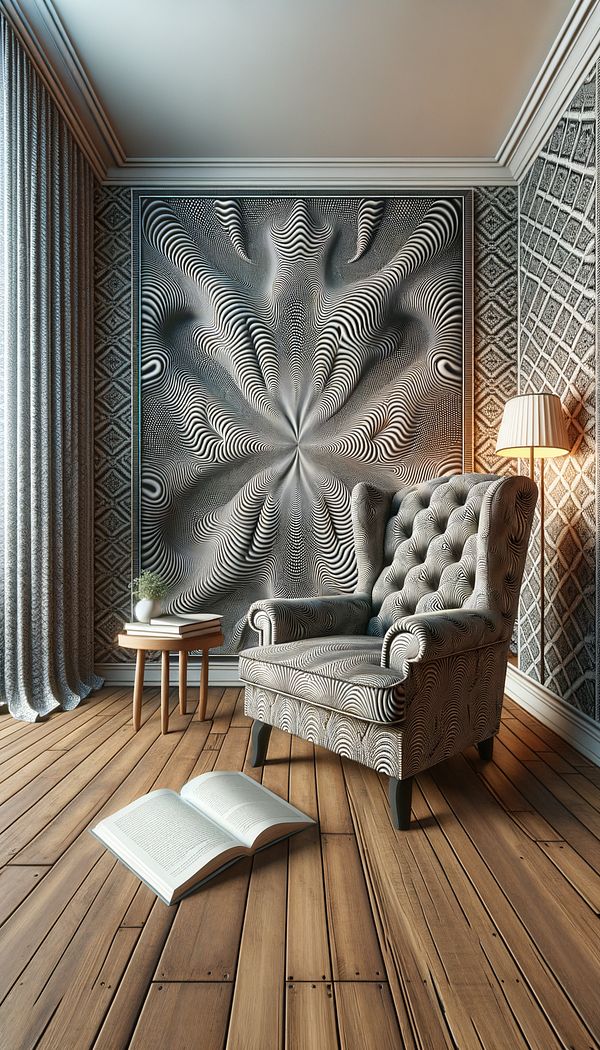What is Moiré?
Moiré is a unique visual phenomenon produced by the superimposition of two or more sets of fine patterns or grids.
Description
Moiré, often referred to in the context of textiles, describes the wavy or rippled appearance that occurs when two or more patterns are layered over one another and slightly misaligned. This effect can create a sense of depth and movement, producing a distinctive visual texture that's both intriguing and mesmerizing. In interior design, moiré is not limited to textiles but can also occur in wallpapers, flooring designs, and other decorative elements where repetitive patterns intersect.
The moiré effect can be both intentional and accidental, with each offering its unique appeal or challenge. When deliberately employed, it can add complexity and vibrancy to a space, making it a popular choice for adding visual interest to interiors. However, when unintentional, it can sometimes lead to visual discomfort or distortion, especially in situations where precise patterns are essential.
Understanding and manipulating the moiré effect requires a keen eye for detail and pattern alignment. Interior designers and decorators use moiré to achieve certain aesthetic goals, taking advantage of its ability to add texture and depth to surfaces without additional physical layering.
Usage
Moiré can be seen in various interior design applications such as in silky wallpaper patterns, intricately patterned area rugs, and on the surface of certain fabric upholsteries. It's also evident in architectural elements where repetitive structural patterns create an interplay of shadows and light, leading to a moiré appearance.
FAQs
-
Can moiré be considered a design flaw?
Moiré can be seen as both a design feature and a flaw, depending on its intentionality. When not desired, it can be considered a flaw due to its potential to cause visual distortion. However, when used purposefully, it's a unique design element that adds depth and interest.
-
How can you avoid unwanted moiré effects?
Avoiding unwanted moiré effects involves careful planning and pattern alignment. In textiles, choosing fabrics with different weaves or densities can help. For wallpapers and other patterned surfaces, ensuring precise alignment during installation is key.
-
Is moiré effect only found in fabrics?
No, the moiré effect can occur in various materials and surfaces beyond fabrics, including wallpapers, metal surfaces, and flooring, wherever repetitive patterns overlap.
Practical Application
To purposefully incorporate moiré into your design, consider using it in accent pieces or focal points within a room, such as a statement wallpaper or a distinctive upholstered piece. The key is to balance its unique texture with simpler elements around it to avoid overwhelming the space. For avoiding unintentional moiré, precise pattern planning and quality control during material installation are essential.
-
Decorating Principles & Elements330 articles
-
Materials & Textiles360 articles
-
Color & Patterns154 articles
-
Textiles & Upholstery252 articles
-
Wall Treatments & Finishes157 articles
-
FlemishFlemish refers to the design and architectural elements originating from the Flanders region of Belgium.
-
PVC - Polyvinyl ChloridePVC, or Polyvinyl Chloride, is a versatile synthetic plastic polymer used extensively in interior design.
-
WatercolorWatercolor is a painting method in which color pigments are suspended in water-based solutions.
-
CartoucheA cartouche is an ornamental frame around a design or inscription.
-
Carver ChairA Carver Chair is a type of dining or armchair originating from the American colonies.
